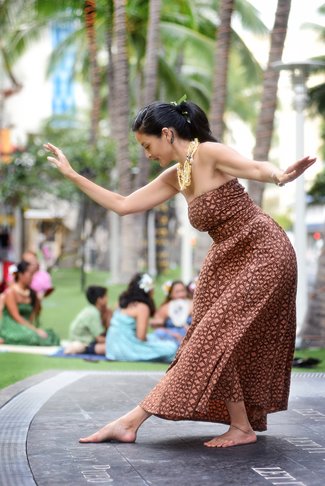One of many mesmerizing styles of dance that exist throughout the Pacific, hula can be traced all the way back to ancient times. Though there are tales of Kauai, Oahu, Molokai, and Big Island each claiming to be the birthplace of hula, its true origin still remains a mystery.
As a form of storytelling dance, hula is characterized by graceful yet precise movements of the hands, hips, and feet to represent the words in a song or chant. A closer look at this enchanting display reveals not only the history of Hawaii, but its folk tales, myths, genealogy, and philosophies as well.
While it is a celebrated part of Hawaiian culture today, the dance nearly disappeared back in the early 19th century. Upon the arrival of American missionaries, who frowned upon the performance of hula, it was subsequently banned in public spaces for a period of time until King David Kalākaua revived it during his reign from 1874–1891. Entering the 20th century, renewed interest in hula and Native Hawaiian culture as a whole catapulted its resurgence. It is now—as it has always been—a sacred practice enjoyed by all who are interested in the stories of Hawaii.
Types of Hula

While various interpretations have sprouted up over its centuries-long history, the dance can be categorized into two major styles: hula kahiko and hula auana.
Hula kahiko—known as ancient hula—is a traditional performance that takes place during a ceremony. In the past, it held religious significance and was a tribute to the gods danced exclusively by men. Some of the sounds you may hear as part of hula kahiko are Hawaiian chanting (called an oli) and the banging of drums or bamboo sticks. While the style is referred to as being “ancient,” newly composed chants are often used alongside generations-old oli, treating viewers to a spiritual artform that is deeply rooted in tradition yet continuing to evolve today.
Hula auana—or modern hula—is a less formal dance that emerged later during the 20th century as more foreigners entered the islands and native Hawaiians began traveling to other countries, bringing in new melodies and dance elements from the Western world. Unlike hula kahiko, modern hula is mainly seen as entertainment without the need for a ceremony and moves to the sound of stringed instruments, such as an ukulele or a steel guitar.
Although it is often performed alongside the rhythmic Tahitian otea and the fiery Samoan knife dance, hula is completely unique to Hawaii and a trip here wouldn’t be complete without seeing at least one performance. Luckily, a hula show is not that hard to find, especially if you’re staying in the Waikiki area.
Weekly Hula Performances
Located just a short distance away from famed Waikiki Beach, visitors can enjoy both watching and learning hula at the Waikiki Beach Walk® shopping center.
Ku Ha‘aheo Show
- Blending contemporary and traditional elements, enjoy this free Hawaiian music and hula performance by adult and keiki (child) dancers at the Plaza Stage every Tuesday from 4:30–6:00 pm.
Ka Lei Hula Class
- In this traditional Hawaiian dance lesson, we start with a welcoming oli followed by stretching and breathing exercises, five basic hula steps, and a little history behind the dance. To sign up, call (808) 664-0102.
Over on the opposite end of Waikiki, you can catch a sunset show at the Kuhio Beach hula mound every Tuesday, Thursday, and Saturday from 6:30–7:30 pm during non-winter months. For more information on the Kuhio Beach Hula Show, click
here.
Notable Hula Festivals
Huge festivals celebrating the art of hula happen all year-round, so if you’re planning a trip to Hawaii in 2020, make a note of these dates to see some of the best hula troupes perform.
Merrie Monarch Festival | April 12–18, 2020
Honoring the legacy of hula proponent, King David Kalākaua, the
Merrie Monarch Festival is Hawaii’s biggest premier hula competition. Held annually in Hilo on the Big Island, top hālaus (hula schools) gather from around the world for a week-long event that perpetuates Hawaiian history and culture.
Event Details:
www.merriemonarch.com
Prince Lot Hula Festival | July 18–19, 2020
Drawing more than 15,000 attendees a year, the
Prince Lot Hula Festival will take place at the iconic Iolani Palace for its 43rd year. There will also be a themed craft fair and cultural demonstrations such as kapa making, lauhala weaving, and more.
Event Details:
www.hawaii.com/event/prince-lot-hula-festival
Aloha Festivals | August 29–September 26, 2020
Originally starting out as “Aloha Week,”
Aloha Festivals has grown into a free, month-long cultural showcase highlighting the unique traditions of Hawaii through music, dance, and culture with community-supported events statewide (though a majority are on Oahu).
Event Details:
www.alohafestivals.com
Holiday Mele | December 19–25, 2020
If you’re in town for the holidays, count down the days until Christmas at Waikiki Beach Walk® with a special musical showcase featuring some of Hawaii’s most renowned hula schools and contemporary Hawaiian music groups.
Event Location: The Plaza Stage